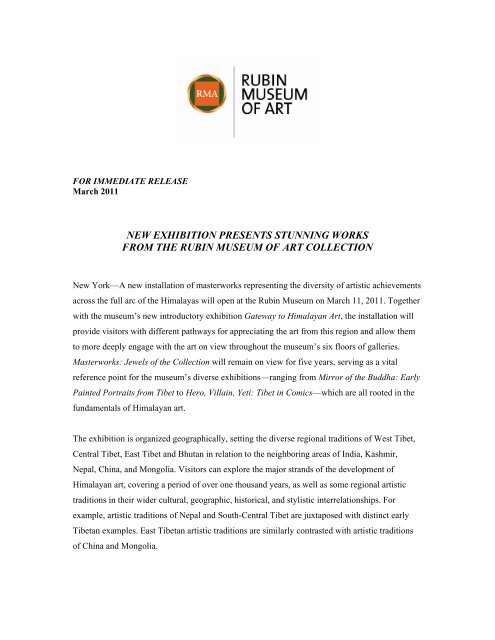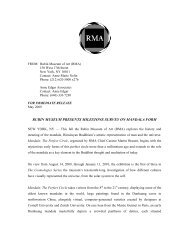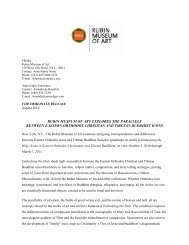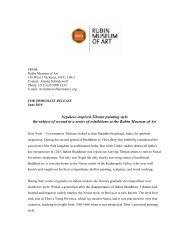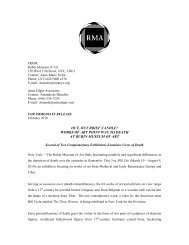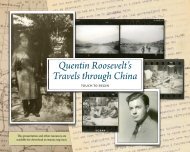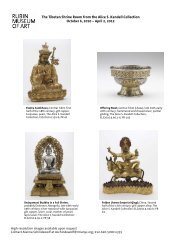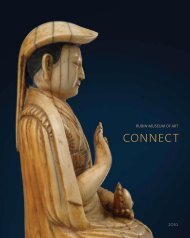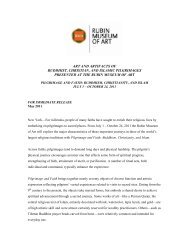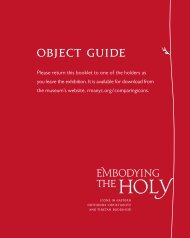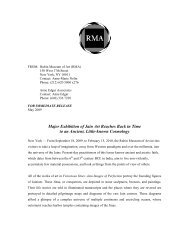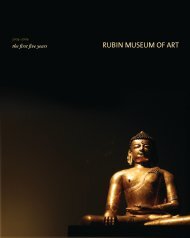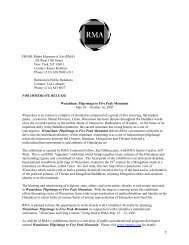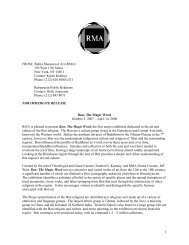Masterworks: Jewels of the Collection - Rubin Museum of Art
Masterworks: Jewels of the Collection - Rubin Museum of Art
Masterworks: Jewels of the Collection - Rubin Museum of Art
- No tags were found...
You also want an ePaper? Increase the reach of your titles
YUMPU automatically turns print PDFs into web optimized ePapers that Google loves.
FOR IMMEDIATE RELEASEMarch 2011NEW EXHIBITION PRESENTS STUNNING WORKSFROM THE RUBIN MUSEUM OF ART COLLECTIONNew York—A new installation <strong>of</strong> masterworks representing <strong>the</strong> diversity <strong>of</strong> artistic achievementsacross <strong>the</strong> full arc <strong>of</strong> <strong>the</strong> Himalayas will open at <strong>the</strong> <strong>Rubin</strong> <strong>Museum</strong> on March 11, 2011. Toge<strong>the</strong>rwith <strong>the</strong> museum’s new introductory exhibition Gateway to Himalayan <strong>Art</strong>, <strong>the</strong> installation willprovide visitors with different pathways for appreciating <strong>the</strong> art from this region and allow <strong>the</strong>mto more deeply engage with <strong>the</strong> art on view throughout <strong>the</strong> museum’s six floors <strong>of</strong> galleries.<strong>Masterworks</strong>: <strong>Jewels</strong> <strong>of</strong> <strong>the</strong> <strong>Collection</strong> will remain on view for five years, serving as a vitalreference point for <strong>the</strong> museum’s diverse exhibitions—ranging from Mirror <strong>of</strong> <strong>the</strong> Buddha: EarlyPainted Portraits from Tibet to Hero, Villain, Yeti: Tibet in Comics—which are all rooted in <strong>the</strong>fundamentals <strong>of</strong> Himalayan art.The exhibition is organized geographically, setting <strong>the</strong> diverse regional traditions <strong>of</strong> West Tibet,Central Tibet, East Tibet and Bhutan in relation to <strong>the</strong> neighboring areas <strong>of</strong> India, Kashmir,Nepal, China, and Mongolia. Visitors can explore <strong>the</strong> major strands <strong>of</strong> <strong>the</strong> development <strong>of</strong>Himalayan art, covering a period <strong>of</strong> over one thousand years, as well as some regional artistictraditions in <strong>the</strong>ir wider cultural, geographic, historical, and stylistic interrelationships. Forexample, artistic traditions <strong>of</strong> Nepal and South-Central Tibet are juxtaposed with distinct earlyTibetan examples. East Tibetan artistic traditions are similarly contrasted with artistic traditions<strong>of</strong> China and Mongolia.
Over <strong>the</strong> next five years, <strong>Masterworks</strong> will include representations <strong>of</strong> a wide range <strong>of</strong> Buddhistand Hindu deities, rendered in all major media including stone, metal, wood, ground mineralpigments on cloth, paper, appliqué, ivory, silk, ink, and papier-mâché. An inscribed metalworklion throne from Karakorum Highway (now in nor<strong>the</strong>rn Pakistan) is <strong>the</strong> exhibition’s earliestwork, dating to <strong>the</strong> early 7 th century. Works from <strong>the</strong> 9 th through 19 th centuries will also be onview.Life-size facsimiles <strong>of</strong> an entire sequence <strong>of</strong> murals from <strong>the</strong> Lukhang, <strong>the</strong> Dalai Lamas’ SecretTemple near <strong>the</strong> Potala Palace in Lhasa, Tibet, provide an exceptional opportunity for viewingHimalayan art at its most lavish. The original 18 th century wall paintings—inaccessible to <strong>the</strong>public until <strong>the</strong> late 20 th century—uniquely depict <strong>the</strong> most esoteric <strong>of</strong> meditation and yogapractices in vivid color and detail. Created with new photographic methods by Thomas Laird andClint Clemens, this display <strong>of</strong> large-format, high resolution pigment prints allows for even betteraccess to <strong>the</strong> paintings than is possible in <strong>the</strong> temple itself. Their presentation at <strong>the</strong> <strong>Rubin</strong> marks<strong>the</strong> first showing in <strong>the</strong> world <strong>of</strong> prints created using this technology, and also provides <strong>the</strong> firstever opportunity outside Tibet to view life-size Tibetan murals in <strong>the</strong>ir relationship to portable artfrom <strong>the</strong> region.<strong>Masterworks</strong> will also highlight <strong>the</strong> museum’s most notable recent acquisitions, all <strong>of</strong> which haverarely or never before been exhibited. Works <strong>of</strong> particular note on view during <strong>the</strong> first year <strong>of</strong> <strong>the</strong>exhibition include an immensely dense and colorful scroll painting <strong>of</strong> a group <strong>of</strong> protective deitiesfrom <strong>the</strong> 18 th century; one <strong>of</strong> <strong>the</strong> few known large coral-studded masks from Mongolia in <strong>the</strong>world; and a recently restored embroidered image <strong>of</strong> Vajrapani that represents a unique imagemakingtechnique perfected by Tibetan Buddhist teachers under <strong>the</strong> lavish patronage <strong>of</strong> <strong>the</strong>Chinese court.Support<strong>Masterworks</strong>: <strong>Jewels</strong> <strong>of</strong> <strong>the</strong> <strong>Collection</strong> was made possible, in part, with anaward from <strong>the</strong> National Endowment for <strong>the</strong> <strong>Art</strong>s.2
About <strong>the</strong> <strong>Rubin</strong> <strong>Museum</strong> <strong>of</strong> <strong>Art</strong>The <strong>Rubin</strong> <strong>Museum</strong> holds one <strong>of</strong> <strong>the</strong> world’s most important collections <strong>of</strong> Himalayanart. Paintings, pictorial textiles, and sculpture are drawn from cultures that touch upon <strong>the</strong> arc <strong>of</strong>mountains that extends from Afghanistan in <strong>the</strong> northwest to Myanmar (Burma) in <strong>the</strong> sou<strong>the</strong>astand includes Tibet, Nepal, Mongolia, and Bhutan. The larger Himalayan cultural sphere,determined by significant cultural exchange over millennia, includes Iran, India, China, CentralAsia, and Sou<strong>the</strong>ast Asia. The museum explores <strong>the</strong>se rich cultural legacies—largely unfamiliarto Western viewers—from a variety <strong>of</strong> perspectives, <strong>of</strong>fering multiple entry-points forunderstanding and enjoying <strong>the</strong> art <strong>of</strong> <strong>the</strong> Himalayas.Admission to RMA is $10 for adults; $5 for seniors; $5 for students (with ID); free for seniors<strong>the</strong> first Monday <strong>of</strong> every month; and free for children under 12 and for museum members.Gallery admission is free to all on Fridays between 6pm and 10pm.Open Monday 11 am to 5 pm, Wednesday 11 am to 7 pm, Thursday 11 am to 5 pm, Friday 11 amto 10 pm, Saturday and Sunday from 11 am to 6 pm; closed on Tuesday. To reach <strong>the</strong> museum bysubway, visitors may take <strong>the</strong> A, C or E to 14th Street; <strong>the</strong> 1 to 18th Street; 1, 2, 3 to 14th Street;F and M to 14th Street; N, R, Q, 4, 5 and 6 to 14th or <strong>the</strong> L to 6th Avenue. By bus, visitors maytake <strong>the</strong> B20 to <strong>the</strong> corner <strong>of</strong> 7th Avenue and 17th Street.For fur<strong>the</strong>r information and images, please contact:Chris D’Aleo / Alina SumajinResnicow Schroeder Associates212-671-5178 / 212-671-5155cdaleo/asumajin@resnicowschroeder.comAlanna Schindewolf<strong>Rubin</strong> <strong>Museum</strong> <strong>of</strong> <strong>Art</strong>212-620-5000 x335Aschindewolf@rmanyc.org3


